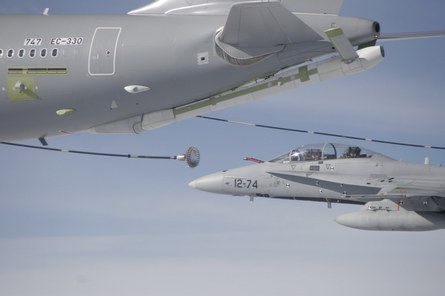EADS has flight-tested the refueling pods on the first KC-30B multi-role tanker transport for Australia. The tests demonstrated the stability of the hose and drogue, but did not involve contact with the Boeing F-18 fighter acting as the receiver aircraft.
On the same flight, EADS says, the Airbus A330-based KC-30 joined up with the company's A310 advanced refueling boom system (ARBS) testbed to confirm the boom's compatibility with a large receiver aircraft. Again the test did not involve in-flight contact.

© EADS
On the test flight, the KC-30's two wing-mounted Sargent Fletcher FRL 905E refueling pods extended hoses and drogues to lengths of 22.9m (75ft), 25m and 27.4m in multiple deployments at altitudes from 10,000ft to 35,000ft and airspeeds from 180kt (335km/h) to 300kt.
Deployments were made with the aircraft in level flight and while banking, to simulate a typical refueling orbit, and and the hose and drogue system demonstrated "complete stability", says EADS.
During the tests, a Spanish air force F-18B made operational-type approaches to pre-contract position behind the extended drogues. Australia will use the KC-30 to refuel its F-18s, as well as F-111s and F-35s.

© EADS
Joining up with the A310 testbed, the ARBS was extended as the KC-30 moved to within 150mm (6in) of the fly-by-wire boom. The A310 made the initial in-flight dry contacts in December, with a Lockheed Martin F-16 acting as the receiver.
The first "wet" contacts, in which fuel will be transferred, are scheduled for early this year. Development of the boom is running well behind EADS's original schedule, and delivery of the first of five KC-30Bs to the Royal Australian Air Force has been delayed to February 2009.
Source: FlightGlobal.com
















